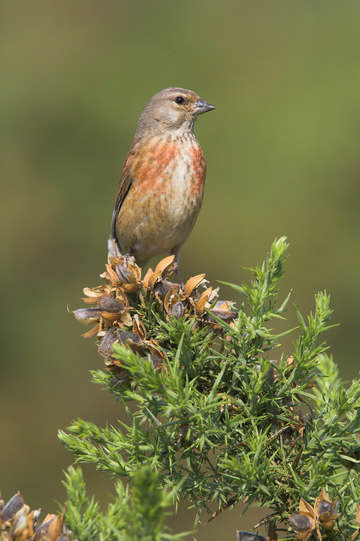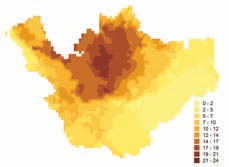
Linnet © Simon Booth
This survey shows that breeding season Linnets were recorded in 163 fewer tetrads than during our First Atlas. There are some areas where it is still almost ubiquitous, notably the western half of Wirral (and this is one of the few breeding species able to eke out an existence on Hilbre) and a broad swathe from Stanlow to Warrington. The most concentrated losses, evident from the ‘change’ map, are in the most intensely agricultural areas in the south of the county. Linnets have no problem breeding in urban or industrial sites, provided that there are some suitable weedy areas.
Linnet was one of the first species to suffer from changed agricultural practice from the 1960s onwards, perhaps because their favoured foods, small weed seeds, were among the earliest to be hit by modern herbicides. The national breeding population was already dropping when our First Atlas started in 1978, and fell by almost 40% during the seven years of that survey (1978-84) but the population has largely stabilised since then, with the decline arrested as some birds learned to feed on oilseed rape as the seeds ripened during the second half of their breeding season (Moorcroft et al 2006). Their national population index was some 20% lower in 2004 than in 1984. Although the Linnet population has dropped, their distribution has not noticeably contracted at the 10-km square scale, indicating that they remain widespread but at lower density (Fuller et al 1995). Despite their decline, Linnets still make it into the top twenty most abundant passerines in Cheshire and Wirral. The BTO BBS analysis gives an estimate with wide confidence limits for the breeding population of the county in 2004-05: 17,830 birds (9,340-26,330), corresponding to an average of about 52 birds per tetrad with confirmed or probable breeding, or 43 birds per tetrad in which the species was recorded.

Linnet abundance.
Adult birds feed themselves on small weed seeds, and regurgitate the contents of their crops for their chicks. Dandelions are the dominant food for chicks of early broods, with rape assuming key importance from mid-June onwards. Although there is far less rape grown in Cheshire and Wirral than in the arable east of England, Linnets will fly long distances from their nest, foraging flocks moving as far as 3 km to find suitable food. Their long breeding season, from April to the end of August, allows some birds to raise as many as three broods. They nest semi-colonially, especially in gorse, hawthorn or other dense scrub, and each pair defends a small area around the nest, but they do not keep to a feeding territory and breeding birds gather together to feed in flocks. More than two-thirds (68%) of the habitat codes were farmland, mostly grassland, with 3% semi-natural grassland, 17% scrub and 7% human sites.
Sponsored by Hilbre Observatory and Ringing Station

